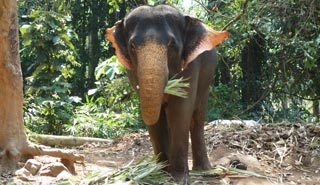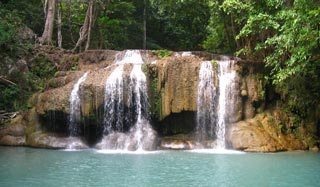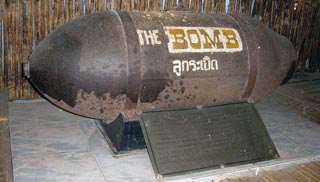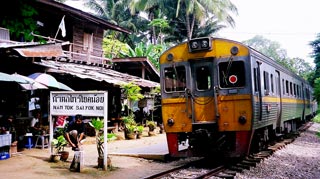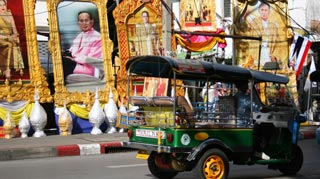Hellfire Pass
For those interested in the history of this infamous railway, Hellfire pass is the final chapter of the journey that commences at the Bridge, continues at the war cemeteries and war museums in town and ends here, high in the hills. A visit to the beautifully maintained museum, together with the shrine to the hundreds of thousands who lost their lives, and the walk down the hillside staircase to see remnants of the railway below, is an experience you will never forget. Located 80km north-west of Kanchanaburi, Hellfire Pass is a 4km long railway cutting which was cut through solid rock by Allied POW's. The flickers from burning torches onto the gaunt faces of half-dead, skeletal labourers working through the night, is said to resemble something out of Dante's inferno - hence the name. Hellfire Pass was a particularly difficult section of the line to build as it was the largest rock cutting on the railway, and its remote location and lack of proper construction tools made it even harder. The Allied Prisoners of War were required to work 18 hours a day to complete the cutting and sixty-nine men were beaten to death by Japanese guards in the six weeks it took to build, with many more dying from cholera, dysentery, starvation, and exhaustion. The memorial museum, which was built and is maintained by the Australian government, is located just above Hellfire Pass (Konyu Cutting). Opened in 1998, it is dedicated to the Allied prisoners of war and Asian labourers who suffered and died at Hellfire Pass and elsewhere in the Asia-Pacific region during World War II. It is not so much a ‘museum’ as an interpretive centre which prepares visitors for the experience of visiting the cutting below. There is a free audio guide, which has detailed descriptions of the area and fascinating anecdotes from survivors. Before descending to the pass itself, walk out onto the contemplation deck where you will find a Peace Vessel which overlooks the Kwai Noi valley. The beauty of the landscape helps to sustain the message of tranquillity and peace. Then walk down the long staircase to the trail that follows the original rail bed. Half way down, stop at a viewpoint to see the 110m length of track cut through solid rock, 17m thick. At the start of the hiking trail, you will see a black stone pyramid memorial to all who suffered and died. If you are up to it, you can take a hike along 3km of the original 4.5km railway, where you will find odd remnants of the original railway. It is quite an arduous walk in the hot afternoon sunshine, and will leave you in awe as to how on earth anyone could survive even one day in such an environment. The museum is located on Route 323, around 80km north-west of Kanchanaburi town. Any bus to Thong Pha Phum or Sangkhlaburi will pass by here. You can also come by motorbike, although it's quite a long ride. Admission is free but donations are welcome.
Kanchanaburi
Kanchanaburi













